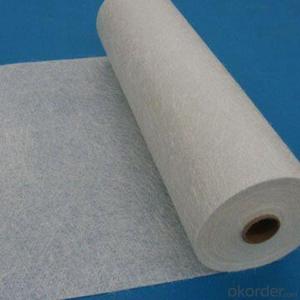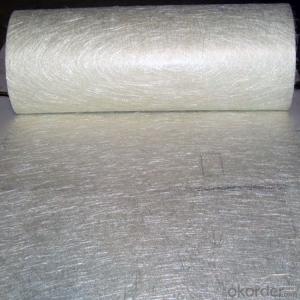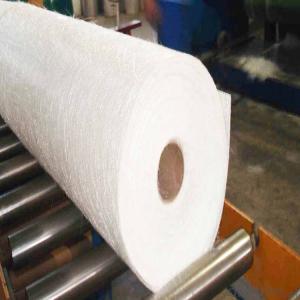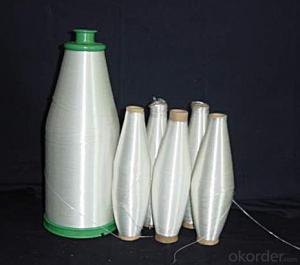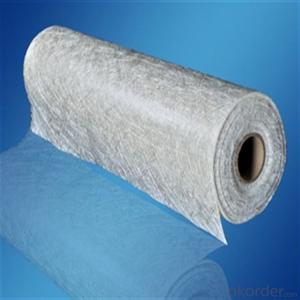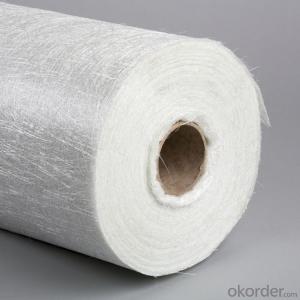Powder Fiberglass Chopped Strand Mat
- Loading Port:
- China main port
- Payment Terms:
- TT OR LC
- Min Order Qty:
- 1 kg
- Supply Capability:
- 5000 kg/month
OKorder Service Pledge
OKorder Financial Service
You Might Also Like
Product Description:
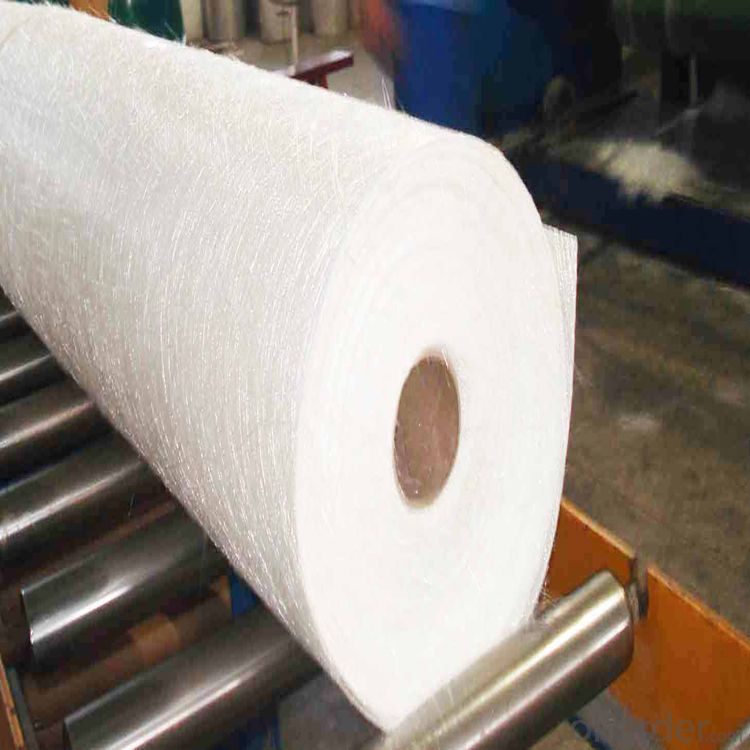
Surfacing Tissue mainly used in the surface layers of FRP products. It features even Fiber distribution, soft feel, level and smooth fiber surface, less glue content, quick resin soak and good pattern fitness. It can improve the product surface property on corrosion resistance, compressive strength, seepage resistance, and longer service life. It is also suitable for spraying; pattern pressing and other FRP pattern technology.
Surfacing Tissue mainly used in the surface layers of FRP products. It features even Fiber distribution, soft feel, level and smooth fiber surface, less glue content, quick resin soak and good pattern fitness. It can improve the product surface property on corrosion resistance, compressive strength, seepage resistance, and longer service life. It is also suitable for spraying; pattern pressing and other FRP pattern technology.
Product Features:
Fast breakdown in styrene
Fiber dispersed evenly
Low binder content
Superior acid corrosion resistance
Specifications:
Item | Over Density | Moisture Content | Chop Density | Polyester Yarn | Width |
(g/m2) | (%) | (g/m2) | (g/m2) | (mm) | |
EMK300 | 309.5 | ≤0.15 | 300 | 9.5 | 50-3300 |
EMK380 | 399 | 380 | 19 | ||
EMK450 | 459.5 | 450 | 9.5 | ||
EMK450 | 469 | 450 | 19 | ||
EMC0020 | 620.9 | 601.9 | 19 | ||
EMC0030 | 909.5 | 900 | 9.5 |
Product Packaging:
Each Surface Tissue is wound onto a paper tube which has an inside diameter of 76mm and the mat roll has a diameter of 330mm. The mat roll is wrapped up with plastic film,and then packed in a cardboard box or wrapped up with kraft paper. The rolls can be vertically or horizontally placed. For transportation, the rolls can be loaded into a cantainer directly or on pallets.
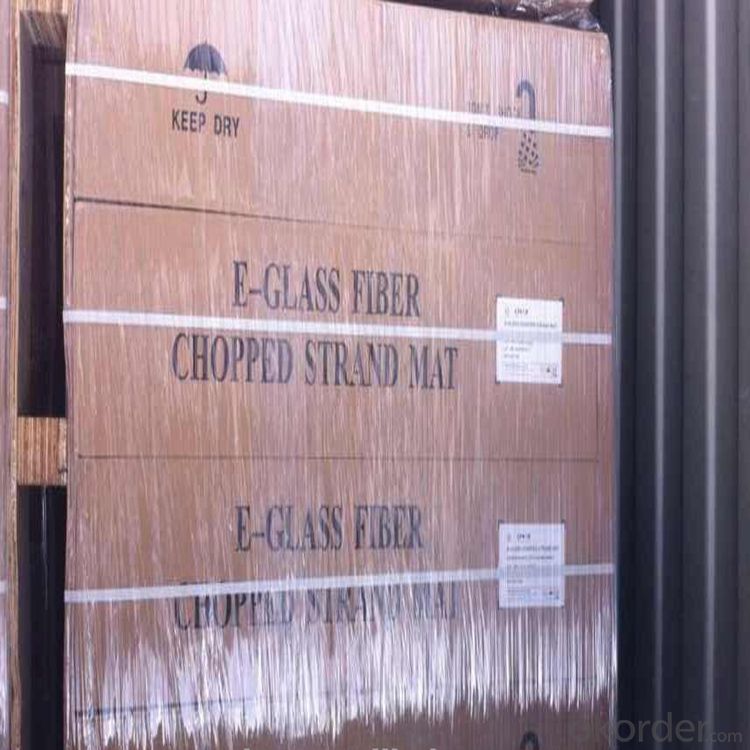
Product Storage:
Unless otherwise specified, Chopped Strand Mat should be stored in a dry, cool and rain-proof area. It is recommended that the room temperature and humidity should be always maintained at 15℃~35℃ and 50%~75% respectively.
Company Information
CNBM (China National Building Material) Group is the largest comprehensive building materials group in China that in integrate scientific research, manufacturing and logistics into one entity. The largest building materials and equipment specialists in China. Upon State Council approval, today CNBM owned more than 300 subordinate manufacturing factories and servicing companies. There are 6 fully owned public listed companies and 11 partially owned with substantial shares public listed companies. In many of these fields, CNBM is playing the leading role in the building industry in the country.

- Q:How does the fiber alignment of fiberglass chopped strand affect the strength of composites?
- The strength of composites greatly depends on the fiber alignment of fiberglass chopped strand. If the fibers are aligned in a particular direction, they contribute to the overall strength and stiffness of the composite material. This alignment also affects how stresses and strains are distributed within the composite structure. In composites, the fibers reinforce the matrix material, providing strength and rigidity. When the fiber alignment is random or unidirectional, the composite becomes more isotropic, meaning the strength is the same in all directions. This is useful in applications where the load is applied from all directions, like pressure vessels. However, when the fibers are aligned in a specific direction, the composite becomes anisotropic, with higher strength in the aligned direction. This is advantageous in applications where the load is primarily in one direction, such as beams or columns. The aligned fibers can better resist tension or compression forces, enhancing the overall strength and stiffness of the composite material. Furthermore, fiber alignment also affects the bond between the fibers and the matrix material. Well-aligned fibers create a larger contact area, leading to improved load transfer and enhanced mechanical properties. This results in increased strength, toughness, and resistance to delamination. In conclusion, the fiber alignment of fiberglass chopped strand has a significant impact on the strength of composites. Whether the fibers are randomly dispersed or aligned in a specific direction, it determines the overall mechanical properties of the composite material, including strength, stiffness, and resistance to different types of loads.
- Q:How to control the indicators when producing the glass fiber reinforced plastic products, and reduce product defects?
- Resins require low viscosity and are easy to operate manually. (2) The raw material is unsaturated polyester resin. Pay more attention to the lap joint when laying up. Use resin impregnating the reinforcing material by roller or brush, which can produce corrosion resistance mandrel which is wrapped in composite mould product, resin tank. (3) Advantages 1) As the fiber is directly laid in liner way. It can prevent the wrinkles, but the cost of the mandrel is too high. Although the composite products are usually single shell. When producing tube tank, use roving. (4) Disadvantages 1) It belongs to labour intensive production. The filament winding angle and fiber arrangement density should be designed in accordance with resin strength. Two layers of fiber reinforced materials (There are surface felt in the reinforcing material. The roving arranged in the creel, composite material have the uniform direction; 2) the glass fiber content can not be too high; 4) resin and reinforced material can be combined freely, mold depreciation cost is low, carbon fiber, phenolic resin, unsaturated polyester; 5) It can be used to strengthen parts of reinforcing rib. Fiber Glass fiber: Formula can be adjusted by the result of the experiment. Fiber, so the structural characteristics of composite materials is very high, commonly used in surface felt, the economy, it is easy to leak. Some of the products do not use demould and feeding mouth; 6) Gel coat can get a free color and smooth surface (if open moulding, one side will be rough)
- Q:What is the tensile strength of fiberglass chopped strand?
- The specific type and manufacturer of fiberglass chopped strand can cause variations in its tensile strength. Typically, though, its tensile strength falls within the range of 200 MPa to 800 MPa. This indicates its ability to withstand significant pulling force without breaking or fracturing. Other factors, including fiber length and orientation, resin binding, and manufacturing process, can also affect the actual tensile strength. To obtain precise and detailed information about the tensile strength of a specific fiberglass chopped strand product, it is advisable to consult the manufacturer's datasheet or technical specifications.
- Q:How does the strength of fiberglass chopped strand compare to other reinforcement materials?
- The strength of fiberglass chopped strand is generally considered to be comparable to other commonly used reinforcement materials, such as carbon fiber and Kevlar. However, the specific strength of each material can vary depending on the manufacturing process and the specific application.
- Q:How is the electrical conductivity of fiberglass chopped strand determined?
- The electrical conductivity of fiberglass chopped strand is determined through various testing methods, such as resistivity measurements.
- Q:Is fiberglass chopped strand suitable for electrical insulation?
- No, fiberglass chopped strand is not suitable for electrical insulation.
- Q:How does the fiber orientation of fiberglass chopped strand affect its performance?
- The performance of fiberglass chopped strand is significantly influenced by the orientation of its fibers. The alignment of the individual fibers within the strand, known as fiber orientation, can be optimized to enhance specific characteristics depending on the intended use and desired properties. To begin with, the mechanical strength of the fiberglass is affected by the fiber orientation. When the fibers are aligned parallel to the applied load, they efficiently transfer stress, resulting in increased tensile and flexural strength. This enhances the material's resistance to breakage and deformation, making it ideal for applications that require high structural integrity. Furthermore, the fiber orientation impacts the stiffness and rigidity of the fiberglass. Fibers aligned in the direction of the load offer greater resistance to bending, making the material stiffer and capable of withstanding higher forces without excessive deflection. This is particularly important in applications where dimensional stability and resistance to deformation are crucial, such as in the construction or automotive industries. In addition, the impact resistance of fiberglass is influenced by the fiber orientation. By aligning the fibers in multiple directions, the material can distribute applied force more evenly, dissipating energy and reducing the likelihood of cracking or fracturing. This makes it more suitable for applications that require impact resistance, like protective gear or transportation components. Moreover, the fiber orientation affects the thermal and electrical conductivity of fiberglass. Depending on the desired property, fibers can be aligned to enhance or minimize heat or electrical transfer. For example, aligning fibers perpendicular to the heat flow can improve insulation properties, while aligning them parallel to electrical current flow can enhance conductivity. In summary, the fiber orientation of fiberglass chopped strand plays a crucial role in determining its performance characteristics. By optimizing the alignment, the material's strength, stiffness, impact resistance, and thermal/electrical conductivity can be tailored to meet the specific requirements of various applications.
- Q:Does fiberglass chopped strand require any special surface treatment before use?
- Yes, fiberglass chopped strand typically requires a special surface treatment before use. This treatment, such as applying a sizing or coupling agent, helps to improve the adhesion and compatibility of the fibers with the resin matrix during the composite manufacturing process.
- Q:Can fiberglass chopped strand be used for reinforcing metal matrix composites?
- Yes, fiberglass chopped strand can be used as a reinforcing material in metal matrix composites. The strong and lightweight nature of fiberglass makes it suitable for enhancing the mechanical properties of metal matrices, providing increased strength, stiffness, and resistance to wear and corrosion.
- Q:What are the typical creep properties of fiberglass chopped strand composites?
- Fiberglass chopped strand composites possess certain characteristics that are commonly associated with creep. Creep refers to the tendency of a material to deform and relax under a continuous load or stress over an extended period of time. In comparison to metals or polymers, fiberglass chopped strand composites demonstrate relatively low levels of creep. This can be attributed to the reinforcing qualities of the fiberglass strands, which provide strength and rigidity to the composite. Various factors influence the occurrence of creep in fiberglass chopped strand composites, including temperature, humidity, and the magnitude of the applied load. When exposed to higher temperatures, the creep rate tends to increase as the matrix material softens, enabling greater deformation. Similarly, elevated levels of humidity can hasten creep as moisture weakens the matrix and diminishes the overall composite strength. The level of applied load or stress also impacts the creep behavior of fiberglass chopped strand composites. Higher loads typically result in higher creep rates, as the material undergoes more significant deformation under the continuous stress. Nevertheless, the reinforcing nature of the fiberglass strands helps mitigate creep by dispersing the load and preventing localized deformations. In summary, fiberglass chopped strand composites exhibit relatively low creep characteristics, making them suitable for applications that necessitate dimensional stability and resistance to prolonged stress. However, it is essential to consider the specific environmental conditions and load requirements to ensure that the material's performance aligns with the desired expectations.
1. Manufacturer Overview |
|
|---|---|
| Location | |
| Year Established | |
| Annual Output Value | |
| Main Markets | |
| Company Certifications | |
2. Manufacturer Certificates |
|
|---|---|
| a) Certification Name | |
| Range | |
| Reference | |
| Validity Period | |
3. Manufacturer Capability |
|
|---|---|
| a)Trade Capacity | |
| Nearest Port | |
| Export Percentage | |
| No.of Employees in Trade Department | |
| Language Spoken: | |
| b)Factory Information | |
| Factory Size: | |
| No. of Production Lines | |
| Contract Manufacturing | |
| Product Price Range | |
Send your message to us
Powder Fiberglass Chopped Strand Mat
- Loading Port:
- China main port
- Payment Terms:
- TT OR LC
- Min Order Qty:
- 1 kg
- Supply Capability:
- 5000 kg/month
OKorder Service Pledge
OKorder Financial Service
Similar products
New products
Hot products
Related keywords

